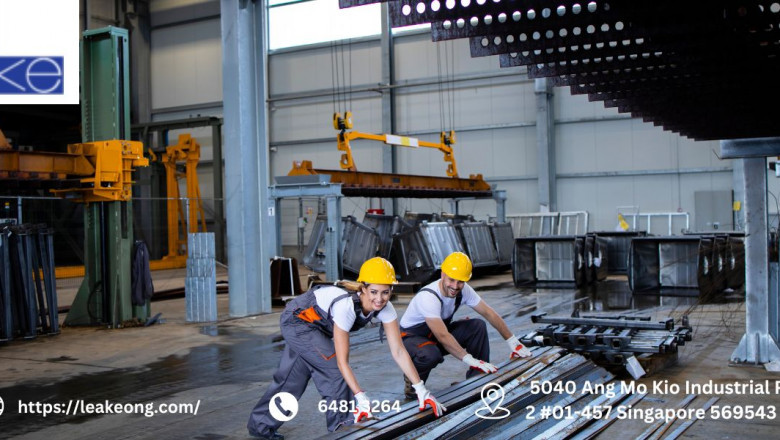views
Steel helps builders raise strong buildings, bridges, and towers. But steel alone doesn’t do all the work. Builders pick different kinds of steel and mix in other parts to help it stay firm, last long, and carry big loads. This work is called steel structure fabrication.
It means shaping, cutting, and joining steel pieces to build strong frames. Each part plays a role. Some stop rust, some lift weight, and some bend without breaking. Knowing which one to use helps builders save time, money, and effort.
In this blog, we will explore the most common materials used in this process. We will learn how each one helps buildings stay safe and strong for many years. Let’s start by looking at the first material—mild steel.
Mild Steel: The Most Used Steel
Bends Without Breaking
Builders often grab mild steel when they need something strong yet easy to shape. This steel bends, stretches, and joins without snapping. Workers cut it, twist it, and weld it to form frames, roofs, and beams.
Keeps Costs Down
Mild steel doesn’t cost much and does its job well. It stays steady under heavy loads. People trust it for homes, shops, and big halls. Builders love how mild steel follows their plan without trouble.
Stainless Steel: Shiny and Strong
Fights Rust All Day
Stainless steel guards itself with a special coating that stops rust. This makes it perfect for places with lots of water like kitchens, hospitals, or buildings near the sea. It won’t flake or fall apart when wet.
Looks Clean and Polished
Besides being tough, stainless steel also shines. Builders use it when they want something that looks neat and strong. You’ll spot it in railings, outside walls, or inside fancy buildings.
High-Strength Low-Alloy (HSLA) Steel: Super Strong and Light
Carries Big Loads
HSLA steel comes with a mix of strong stuff like copper and nickel. It lifts heavy things but doesn’t add too much weight. This makes it perfect for bridges, towers, and high-rise buildings.
Joins Well
This steel helps welders do clean and neat work. It doesn’t crack easily. That’s why builders reach for it when they need a strong joint or a steady beam in steel structure fabrication.
Galvanised Steel: A Rust Fighter
Wears a Zinc Coat
Galvanised steel wears a jacket made of zinc. This jacket blocks rust and keeps the steel clean. Builders pick it for roofs, fences, and outdoor rails because it holds up under sun and rain.
Lasts a Long Time
The zinc layer hangs on for years. That means less work fixing or changing parts. Builders count on galvanised steel when they want something tough that won’t need too much care.
Carbon Steel: A Simple and Solid Choice
Many Grades, Many Jobs
Carbon steel comes in low, medium, and high strength. Low-carbon bends easily. High-carbon stays stiff. This gives builders lots of choices for rods, bolts, or beams.
Shapes Easily
It doesn’t take much to cut or form carbon steel. It stands firm and doesn’t give up under pressure. Builders often use it in many parts of steel fabrication.
Rebar Steel: The Concrete Helper
Hides in the Concrete
Rebar steel hides inside concrete to make it stronger. Builders slide these rods in before the concrete dries. They help stop cracks and hold the shape.
Grips Tightly
The rough surface on each bar clings to the concrete. This helps the whole thing stay firm when cars roll over it or wind pushes against it.
Structural Steel Sections: Pre-Made Shapes
Ready-Made for Building
Structural steel comes in shapes like I-beams and angle bars. These shapes carry loads in special ways. Builders just lift and place them where needed.
Can Be Cut
If a builder needs a special size, they slice it to fit. These parts speed up the work and make strong connections in the structure fabrication.
Weathering Steel: Rust That Guards
Rusts to Protect
Weathering steel has copper and other parts that make a thin rust layer. This layer guards the rest of the steel. Builders use it where paint peels off or where upkeep is hard.
Looks Rough but Cool
The rusty colour looks nice in outdoor places. Builders don’t need to repaint it. They trust weathering steel in sculptures, bridges, and open spaces.
Alloy Steel: Made for Special Jobs
Mixes for Strength
Alloy steel mixes iron with special metals like nickel or manganese. This gives it powers like heat resistance or extra toughness. Builders use it in places that face heat, cold, or pressure.
Handles Hard Work
Alloy steel doesn’t bend or crack easily. Builders choose it for columns, supports, or heavy tools that need to last a long.
Cast Iron and Steel Plates: Handy Extras
Plates for Support
Steel plates lie flat and connect other parts. They help hold beams and columns in place. Builders bolt or weld them to form solid joints.
Cast Iron for Tight Spaces
Cast iron stays firm and doesn’t change shape. Builders pick it for small parts that must stay strong in corners, edges, or joint spots.
Why Pick the Right Material?
Keeps Buildings Safe
Each material does a job. Some resist rust. Others carry a heavy weight. Builders must pick wisely so the structure stays safe and strong.
Affects Cost and Looks
Some materials cost more. Some last longer. Others shine or stay dull. Picking the right one helps save money and makes the building look better too.
Conclusion
Steel structure fabrication only works well when builders use the right materials. From mild steel to weathering steel, every piece adds strength, safety, or shine.














Comments
0 comment